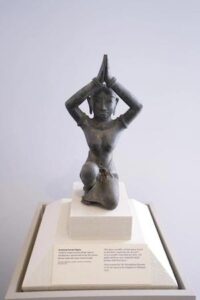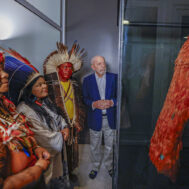On April 25th, 2024, a ceremony was held at the Metropolitan Museum of Art for the signing of a new “memorandum of understanding” between the museum and the government of Thailand. During this event, the Met officially returned two 11th-century metal sculptures that were deaccessioned from its collection in December. The agreement, signed by Max Hollein, the director of the Met, and Nitaya Kanokmongkol, the executive director of the Thai cultural ministry’s office of national museums, emphasizes settling any disputes “amicably” and “in a spirit of mutual respect” without involving third parties. (No names were mentioned, but “third parties” presumably means talking to each other first before involving law enforcement or discussing potential returns with Cambodia, another claimant for Khmer artworks.)

Kneeling woman votive statue, formerly in the collection of the Metropolitan Museum of Art, now returned to Thailand. Courtesy Metropolitan Museum of Art.
A December Met announcement stated that its recent returns to Cambodia and Thailand effectively remove from its collection “all Angkorian sculptural works known by the Museum to be associated with the dealer Douglas Latchford.” The museum’s catalog describes the larger statue, as “the most complete extant gilded-bronze image from Angkor.” It belongs to a small group of metal sculptures of Hindu deities associated with royal cult practices that has been discovered in Khmer territories in Cambodia and northeastern Thailand. The statue, known as “the Golden Boy,” is identified as probably a Standing Shiva, although the catalog points out that its elegant gesturing hands “do not conform to any standard iconographic mudras or hold key attributes.” It may have served as both a cult icon for worship in a royal sanctuary and an ancestor image of a deceased ruler. The sculpture was donated to the museum in 1988 by media mogul Walter H. Annenberg in 1988.
The kneeling woman bronze statue is inlaid with silver and has traces of gold on its surface. Her brows and pupils were originally inlaid, possibly with black glass. The Met inventory describes her posture as kneeling with her arms raised in adoration and indicates that she may have been part of a votive ensemble. The sculpture was acquired by the Metropolitan Museum in 1972.
Representatives from both the Met and Thailand made effusive (and well-deserved) comments about the beauty and importance of the returned works before the signing. Hollein stated that the sculptures “rightfully belong to the Kingdom of Thailand,” while Somjai Taphaopong, the consul-general of Thailand in New York, described them as “magnetic and invaluable objects.” John Guy, the Met’s curator of South and Southeast Asian art, expressed enthusiasm for the sculptures, referring to them as “unsurpassed,” “remarkable,” and “unrivalled masterpieces.”
When the statues’ return to Thailand was first announced in December 2023, Cambodian archaeologist Thuy Chanthuon expressed disappointment that the two statues had been returned to Thailand, not Cambodia, saying return to Thailand was the result of not having an identified findspot in Cambodia despite “enough proof of ownership.” He said that he hoped the Cambodian Ministry of Cultural Affairs could continue to work on the problem.
Both Cambodia’s and Thailand’s governments aver that they are the true heirs of Khmer civilization. While numerous sculptures have been returned to Cambodia from Western countries, the vast majority of looted artifacts of Cambodian origin are known to be held in Thailand, largely in private collections in the hands of business magnates, high level government officials and the military.
Return of Objects to Cambodia and Indonesia

A stone relief sculpture dating from the Majapahit Empire (1293-1527) that was returned to Indonesia. Courtesy Manhattan District Attorney Office.
On April 28, 2024, US authorities announced the repatriation of thirty antiquities, valued at $3 million, to Cambodia and Indonesia as part of ongoing trafficking investigations. Manhattan District Attorney Alvin L. Bragg announced the return of 27 artifacts to Cambodia and three to Indonesia. Most of the items were returned to Cambodian officials in a ceremony attended by the country’s ambassador to the US, Keo Chhea, while the restituted Indonesian artifacts were signed over to that country by Winanto Adi, Indonesia’s consul general in New York.
Among the most recently returned items are pieces associated with Subhash Kapoor and Nancy Wiener, including a bronze “Shiva Triad” arranged to be sent out of Cambodia by Wiener and later donated to the Denver Art Museum. Another artifact, a stone relief sculpture from the Majapahit Empire, was recovered more than ten years ago from a storage unit linked to Kapoor.
Last December, U.S. District Attorney for the Southern District of New York Damian Williams offered a counterpoint to the Metropolitan Museum’s Memorandum of Understanding with Thailand in a recorded statement about returns of objects to Cambodia. In a recorded statement, Williams stressed Homeland Security’s dedication to repatriating objects to source countries, saying to “cultural institutions” that staff and collectors should “come to see us before we come to see you.”
 Standing Shiva, formerly in the collection of the Metropolitan Museum of Art, now returned to Thailand. Courtesy Metropolitan Museum of Art.
Standing Shiva, formerly in the collection of the Metropolitan Museum of Art, now returned to Thailand. Courtesy Metropolitan Museum of Art. 

